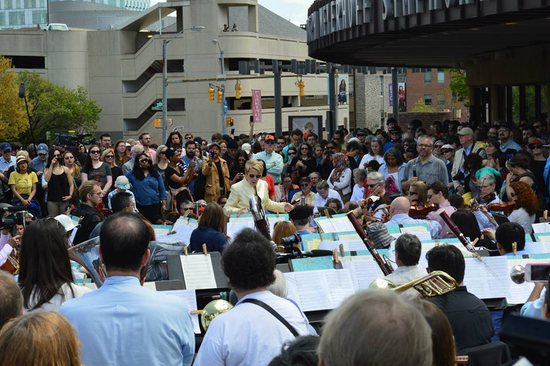After resident Freddie Gray died while in the custody of Baltimore Police, protestors took to the streets of downtown Baltimore seeking justice. Following a week of peaceful protests, the demonstrations turned violent on April 25, as protestors attacked a number of downtown businesses and disrupted an Orioles game at Camden Yards. Several arrests were made and about a dozen police officers were injured. Two days later, riots broke out in northwest Baltimore and at various locations throughout the city, and several businesses were burned and looted. For the first time since the 1968 riots that followed Martin Luther King’s assassination, the Governor of Maryland declared a state of emergency in the city, and National Guard troops, along with hundreds of additional state and local police officers, manned city streets. The Penn-North area was a major locus of unrest, with years of tension between the police and the predominantly working-class African-American community erupting into sparring between police in riot gear and residents. For six days, a curfew was in effect between 10 p.m. and 5 a.m. The curfew tarnished the city’s image and devastated businesses. All of the week’s BSO services were cancelled—the curfew had prevented evening concerts, and area school districts cancelled all trips into Baltimore, forcing the cancellation of the daytime educational performances that happened to be most of the week’s concerts.

Music Director Marin Alsop conducts the BSO
Courtesy of the Baltimore Symphony Orchestra
The Joseph Meyerhoff Symphony Hall, home to the Baltimore Symphony, is located roughly one mile from the hard-hit Penn-North district. The day after the riots, a few musicians sought permission from BSO management to casually read some music outside of the hall, offering solace to each other and any possible listeners. Every musician in the orchestra was personally contacted and invited. This was not meant to be a performance but an unrehearsed “gathering” of musicians. Repertoire was flexible. Once a baroque-sized group signed on, the instrumentation grew from there. The BSO public relations department notified media outlets, the librarians filled folders with potential works, and the operations staff provided chairs, stands, security, and other necessities.
Within five hours, a New York Times article—“Baltimore Symphony to Play Free Outdoor Concert Wednesday”—appeared. Nobody knew what to expect, as the BSO Facebook page quickly received over 14,000 likes. At noon on Wednesday April 28, less than 48 hours after the onset of civil unrest, the musicians of the BSO presented a light, impromptu “gathering” outside of the Meyerhoff. Over 1,000 people from all backgrounds attended, along with dozens of media outlets from around the world. The concert was not about the BSO, it was about the community, which was trying to comprehend the state of the city. Music included selections from Handel’s Music for the Royal Fireworks and Bach’s Orchestral Suite No. 3, with Music Director Marin Alsop conducting the finale of Beethoven Symphony No. 2 to complete the program. The national anthem was performed twice, along with the rarely-heard city anthem from 1914, “Baltimore, Our Baltimore”. The concert received massive worldwide coverage and gave a sense of peace to the troubled city, even for just a half hour.
An educational concert was performed the following day to a (mostly) empty hall. However, the concert was streamed live into classrooms under the terms of the recently approved Integrated Media Agreement. It was a trial run and a good test for future projects. There is a lot more work left to do in Baltimore, and the country. After a week of demonstrations that culminated in indictments against six police officers, the city is back to “normal”. The efforts of the Baltimore Symphony musicians did not go unnoticed. It was a very special and personal moment in the orchestra’s, and the city’s, history. It demonstrated the power and the purpose that a symphony orchestra can provide during times of struggle and soul-searching.
Note: the author is the Chairperson of the BSO Players’ Committee and the organizer of the musician-led event.






[…] Baltimore Symphony Orchestra sent a different message: Its musicians gathered on the sidewalk in front of their concert hall to perform Handel, Bach and Beethoven to a crowd of […]